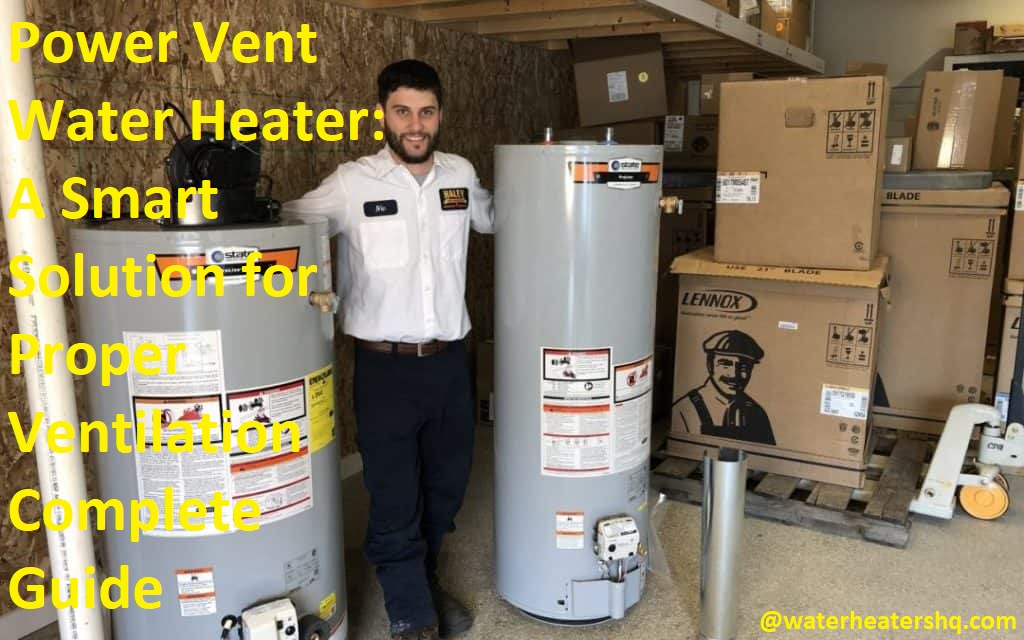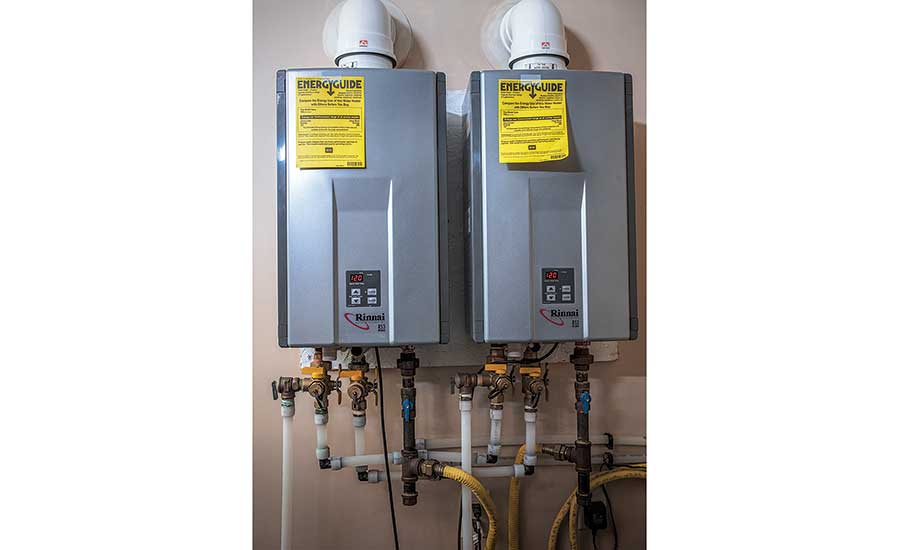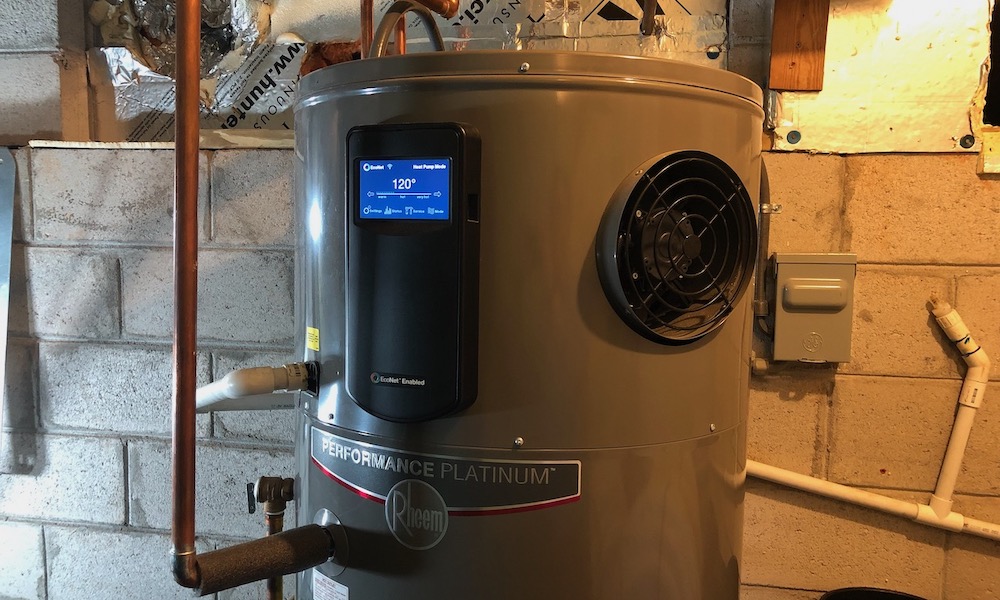Are you looking for a smart way to ensure proper ventilation of your water heater? Look no further. A power vent water heater is the ultimate answer.
Not only will it guarantee proper ventilation, but it will also make your life much easier with its convenience and ease of installation.
Get the full scoop on power vent water heaters here.
Water heaters are an essential and integral part of many homes and business. As the primary source of hot water, it is important to ensure their proper functioning, as well as their safe operation. One key element of a water heater’s proper and safe operation is ensuring that it is properly vented so that dangerous gases can be safely expelled outside.
For many homes and businesses, using a power vent water heater provides the best option for venting, as these units offer greater efficiency along with greater safety than other types of gas-powered water heaters can provide. In this guide to the power vent gas water heater, we discuss the basics of what this unit is and how it works, as well as its pros and cons when compared to other types of hot water heating systems.
Definition of Power Vent Water Heater
A power-vent water heater is a type of water heating system that uses mechanical exhaust fans for venting, rather than relying on natural draft. Natural draft refers to the way hot air rises and exits the top of a device or appliance, while mechanical exhaust fans are used to direct and exhaust hot air from the lower end through pipes.
Power-vent water heaters are used when homes or buildings have poor natural draft conditions, such as tight construction or other environmental factors. The use of power venting reduces operational costs and increases efficiency by utilizing less energy to move exhaust out of the system.

Importance of proper ventilation in water heaters
Proper ventilation is one of the most important considerations when it comes to selecting a water heater. Without adequate ventilation, your water heater will struggle to expel combustion gases which can cause serious safety concerns. Power vent water heaters are equipped with an exhaust fan that transports these hazardous gases outside of your home. This equipment helps to extend the life of the unit and prevents unwanted ventilation problems such as poor performance, mechanical failure, and even carbon monoxide poisoning.
Power vent water heaters are also smart solutions for older homes and cramped spaces where a traditional tank system can inhibit natural air flow. It also works well for homes located in colder climates where regular maintenance becomes more difficult due to frequent bouts of freezing temperatures. Additionally, power vents promote better fuel efficiency since they help burn fuel more efficiently from start-up until shut down.
Overall, whether you’re replacing an old unit or outfitting an existing décor, power vents are a smart solution for proper ventilation in water heaters due to their increased safety features, improved efficiency ratings and space savings benefits.
How Power Vent Water Heaters Work
Power vent water heaters have a built-in fan that uses combustion air from outside the building and exhausts combustion products directly to the outdoors. This type of water heater uses an electrically powered fan to draw in air, mix it with the natural gas or propane used for fuel and make sure that the exhaust products are safely vented outside of your home. In short, this type of water heater is designed to be more energy efficient because it does not rely on natural draft associated with traditional units.
The power vent water heater works by drawing air from outside of your home, mixing it with the fuel being used, and venting the exhaust outside. To make sure that there is sufficient airflow being delivered to the unit, a fan is in place at the top or side of the tank that draws air in and continuously circulates it through an insulated stainless steel combustion chamber. Inside this chamber, operations will be monitored by an electronic spark module as well as a thermocouple which help detect changes in temperature or pressure in order to ensure safe operation. This combination creates superior ventilation which allows for maximum efficiency and longer service life compared to traditional models.
Description of Power Vent Water Heater
Power vent water heaters are a smart solution for proper ventilation in the home and provide improved thermal efficiency and savings by eliminating the need for traditional vent pipe installation. These water heaters have an internal fan that circulates exhaust gases under negative pressure, helping to draw out any stale air in the room. By operating at higher temperatures than traditional units, a power vent model can save up to 20% more energy costs each year.
Power vents are also designed to be installed on outside walls, avoiding any awkward installation areas such as basements or attics. This can significantly reduce installation time and cost, while making it easier to ensure proper ventilation of your home’s space. Furthermore, power vent water heaters are usually highly reliable due to their motor-driven designs.
Finally, since they are built with a sealed combustion chamber that prevents any loss of heated air out of the exhaust pipe, these units almost always require less maintenance than traditional models. So if you want an efficient and effective way to provide proper ventilation throughout your home without having to worry about frequent repairs and maintenance, then a power vent water heater is an ideal choice for you!
Explanation of how it works
Power vent water heaters are a type of water heater that uses an electric blower to help draw air through the system for proper ventilation. This type of air flow is required for the efficient operation of any type of direct vent or natural draft water heater, as it allows exhaust gases to be safely vented away from the home or living space. Without adequate venting, these gases can build up in the surrounding area and become dangerous.
A power vent water heater works by having a fan come on when the exhaust temperature reaches a certain level. The fan activates and pushes warm air out through a pipe that extends outdoors, diverting exhaust gases away from the area and allowing fresh air to enter the room. Properly vented systems also help prevent buildup of dangerous substances such as carbon monoxide, nitrogen dioxide, and other volatile organic compounds (VOCs).
The power vent water heater is different from a traditional tankless boiler, which uses open draft combustion instead. By comparison, power vents reduce energy use while providing ample ventilation because they only run when necessary — generally at times when there is increased ventilation demand such as during showering, running dishwashers/clothes washers/dryers etc. Additionally, power vents cost less to own and operate than traditional boilers since they have lower standby losses and require fewer trips outside for maintenance or repair — saving time and money!
Comparison with other types of water heaters
A power vent water heater offers an efficient and safe solution to the problems associated with venting gas-powered water heaters. With a powered vent, hot gases from the furnace are exhausted directly from the heater’s combustion chamber through a special exhaust fan. This setup eliminates the conventional chimney flue needed for proper ventilation, drastically reducing operation costs.
Power vents are ideal for existing homes or those where space is at a premium. They can be vented using flexible aluminum pipe attached to an existing window or wall, with no need of complex masonry construction typically used for traditional combustible products. Additionally, you can install a power vent remotely from the tank itself on any outside wall, freeing up more interior space.
Power vents offer superior energy efficiency compared to traditional vented water heaters, typically ranging up to 96 percent efficiency in comparison to their 80 percent efficiency rating. And they don’t require periodic maintenance—piped or filtered hoods or feed systems include self-cleaning technology that requires minimal maintenance and labor costs over time. This type of system also reduces noise levels during operation and is quieter when running than traditional units.
Comparatively speaking, power vents tend to cost more than other types of heating options like electric storage tanks and oil-fired boilers but provide significant savings on installation and operating costs over time due to their superior efficiency ratings and lack of maintenance requirements. With careful consideration of your specific home needs, power vents can be an excellent investment for greater comfort and lower energy bills in the long run.

Benefits of Power Vent Water Heater
Power vent water heaters are becoming a popular choice for many households due to their high efficiency ratings, long-term savings potential, and ability to provide precise ventilation. They offer several distinct advantages in comparison to conventional water heaters that must rely on natural air currents in order to function properly.
Power vent water heaters use a powerful motorized fan to extract air from the space and draw it through the heater’s combustion chamber before venting it outdoors. This helps eliminate any dangerous buildup of carbon monoxide and other harmful gases in the home. By providing consistent and adequate ventilation, power vent heaters can also reduce energy costs as they require less energy to maintain optimal temperatures inside the home than conventional models.
Furthermore, since they do not need complicated ductwork or gas piping systems, installation times are significantly shorter which can result in lower installation costs. In addition, these units tend to be relatively small and lightweight compared with their traditional counterparts thus making them highly versatile when it comes to where they can be placed in a home.
Overall, power vent water heaters offer numerous advantages for homeowners looking for an efficient solution for their hot water needs that also provide proper ventilation without compromising on safety or comfort.
Energy efficiency
Power Vent Water Heaters are a modern and energy-efficient solution that allow venting through the roof or side walls of your home. By utilizing energy efficient blower motors, they provide efficient venting without the need for an existing chimney. This smart ventilation system helps to reduce energy costs as well as improve safety, by protecting against moisture, condensation and back drafting. In comparison to traditional water heaters, power-vent systems offer superior performance and decreased overall heating costs.
Power vents are commonly used in areas where a traditional brick and mortar chimney is not a viable option. They are designed to deliver longer operational life spans, with more than 11 years when properly installed and maintained. Utilizing the optimal fuel efficiently, power vents can reduce hot water recovery times by up 50%, improve delivery speeds upon demand for hot shower or sink use and are certified for gas combustion efficiency up to 93%.
In addition, power vents offer many other benefits such as reducing noise through sound-proofed technology, easy installation that requires no complex wiring or tubing changes and added outdoor observation opportunities due to flow limiting valves which slow down the release of exhaust gases when temperatures increase. With modernized features at peak performance levels, it’s easy to understand why employing a power vent water heater is often chosen over traditional water heaters when integrated into modern smart homes.
Reduced risk of carbon monoxide poisoning
Installing a power vent water heater is a smart way to reduce the risk of carbon monoxide poisoning. When using an ordinary water heater, the combustion gases produced by the furnace are sent into your home or building, potentially creating dangerous levels of carbon monoxide if proper venting and ventilation systems are not installed.
With a power vent water heater, these gases are completely vented outside through either gravity vents or powered fans. This means that no carbon monoxide will be allowed to enter the inside of your home which helps to keep your family safe from harm. Additionally, it also helps to reduce indoor air pollution as no exhaust gases will be vented directly into living areas.
Maintenance of Power Vent Water Heater
Proper maintenance is key to optimizing the performance of a power vent water heater. A regular water heater tune-up ensures that your fixture stays in good condition, reduces repair bills and extends its service life. Here are some important tips and steps to keep your system working at its best:
– Make sure the drains are clear of debris and open so any sediment or accumulated minerals can be flushed out.
– Check for leaks regularly and tighten any loose parts. If you spot any visible leaks, contact a qualified technician immediately.
– Schedule regular filter replacements to ensure the air quality is at its peak performance. Make sure all filters are completely free from dirt, dust or other pollutants for optimal results.
– Inspect your tank for rust or corrosion over time and replace if necessary.
– Monitor your water pressure annually to make sure it’s not too high or too low, as either can spell trouble for your appliance’s performance over time.
– If you experience an unusual noise coming from the unit, consider getting it inspected as this may be a sign of a leaky gasket seal or some other issue that needs addressing quickly to avoid further damage down the line.
Regular cleaning and inspection
Regular cleaning and inspection of the power vent water heater is essential for proper operation and safety. Cleaning should be done on a yearly basis and can be done by simply disconnecting the electric power or by turning off the gas supply to the unit.
During the cleaning process, use a vacuum cleaner with a brush attachment to remove dust and debris from inside and around the unit. Additionally, carefully inspect all components of the system (including wiring, plumbing lines, electrical connections, heat exchangers, ignition system parts, vent piping) for signs of corrosion or damage. Be sure to check all gaskets and seals as well as any connecting couplings that may have come loose over time.
In general, it is best to consult a qualified technician for maintenance or repairs on any power vent water heater.

Conclusion
Overall, power vent water heaters offer a number of benefits and advantages that can make them a great choice for a new or replacement installation. Power vent water heaters offer an efficient and convenient way to get the hot water you need without having to worry about inadequate ventilation. By providing proper ventilation, they help reduce potential health risks while allowing you to use the highest efficiency rating available. In addition, if you want to obtain the highest performance levels with your water heater, a power vent model can provide higher BTU ratings and overall better performance than traditional models, even in cold weather conditions. Power vent water heaters come in multiple tank sizes so it’s easy to find one that fits within your budget and has enough capacity to meet your hot water needs.
When making your decision between traditional or power vent units, make sure you take into account the amount of ventilation needed for each type of unit as well as other factors such as availability and cost. With its many advantages, it may be worth considering a power vent model for your new installation or replacement should you be looking for greater efficiency and better performance from your next hot water heater purchase.
FAQ’S
What is the advantage of a power vent water heater?
A power vent water heater can be installed in areas where conventional venting is not possible, and it provides improved energy efficiency and lower operating costs.
What are the venting requirements for a power vent water heater?
A power vent water heater requires a dedicated vent pipe to the outdoors, and it must comply with local building codes and manufacturer specifications.
What is a power vent water heater?
A power vent water heater is a type of gas-fired water heater that uses a fan or blower to force exhaust gases out of the combustion chamber and into a vent pipe.
How efficient is a power vent water heater?
Power vent water heaters are generally more efficient than conventional water heaters, with an Energy Factor (EF) of 0.7 or higher.
What are the benefits of a power vent?
The benefits of a power vent include improved energy efficiency, lower operating costs, and the ability to install in areas with limited or no venting options.
How do I know if I need a power vent water heater?
You may need a power vent water heater if you are unable to install a conventional venting system or if you want to improve energy efficiency and reduce operating costs.
What is the best vent for a water heater?
The best vent for a water heater depends on the specific requirements of the unit and the building code requirements in your area. Common vent types include direct vent, power vent, and atmospheric vent.
What is the purpose of a water vent?
The purpose of a water vent is to remove combustion gases and excess heat from a water heater, ensuring safe and efficient operation.
What are the two advantages of a water heater?
The two advantages of a water heater are providing a constant supply of hot water and improving overall energy efficiency.
Does an electric water heater need ventilation?
Yes, an electric water heater requires ventilation to remove excess heat and humidity from the unit. However, electric water heaters do not produce combustion gases and do not require venting for exhaust purposes.
See Also:
- Best 50-gallon gas water heater
- Best 75 gallon gas water heater
- Best 80 gallon electric water heater
- Best 110 volt tankless water heater for shower
- Best electric tankless water heater


